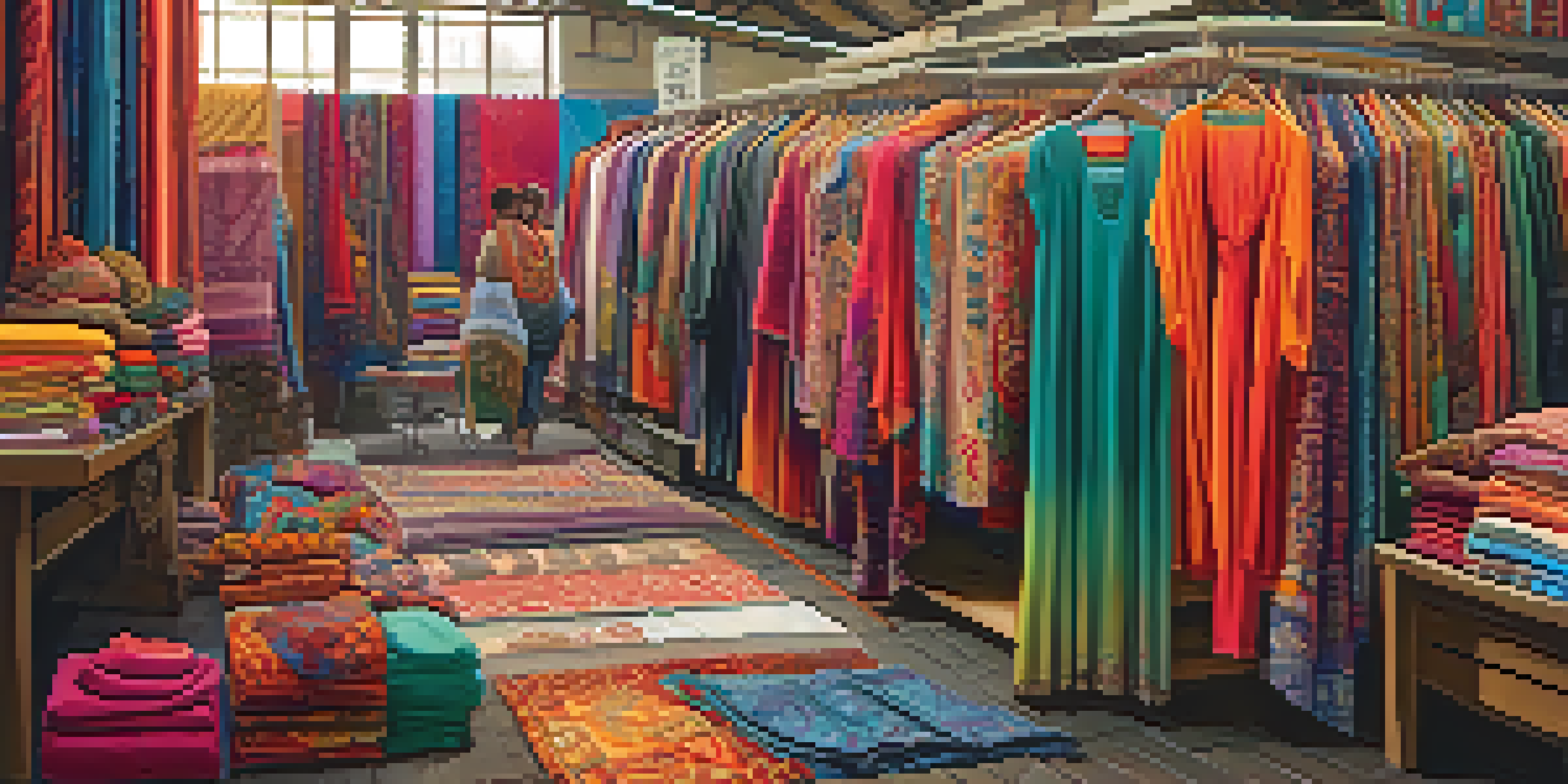The Impact of Globalization on Fashion Supply Chains

Understanding Globalization in the Fashion Industry
Globalization refers to the interconnectedness of economies, cultures, and populations across the world. In the fashion industry, this means brands can source materials and labor from anywhere, tapping into global markets. This interconnectedness has transformed how we view fashion, shifting it from local craftsmanship to a broader, more diverse landscape.
Fashion is the armor to survive the reality of everyday life.
For example, a dress designed in Paris might be made from fabric sourced in Italy, sewn in Bangladesh, and sold in New York. This complex web of production reflects both the efficiencies and challenges of globalization. With advancements in technology, brands can now communicate and manage these far-reaching supply chains with unprecedented ease.
However, this also raises questions about sustainability and ethical practices in fashion. As brands expand their reach, they must consider the environmental and social impact of their supply chains, leading to a growing demand for transparency.
The Role of Technology in Fashion Supply Chains
Technology plays a pivotal role in modernizing fashion supply chains, enabling brands to streamline operations and improve efficiency. From inventory management systems to digital design tools, technology has transformed how fashion companies operate. For instance, 3D printing and virtual fitting rooms are now becoming commonplace, allowing brands to reduce waste and enhance customer experience.

Moreover, the rise of e-commerce has accelerated the need for efficient supply chain management. Consumers expect fast delivery times, pushing companies to optimize their logistics and inventory. Tools like artificial intelligence (AI) and big data analytics help predict trends and manage stock levels, ensuring that brands meet customer demand without overproducing.
Globalization Transforms Fashion
Globalization enables fashion brands to source materials and labor globally, creating a diverse and complex supply chain.
However, this reliance on technology also presents challenges, such as cybersecurity risks and the need for constant updates. Brands must navigate these issues carefully to maintain their competitive edge while ensuring the integrity of their supply chains.
Sustainability Challenges in Global Fashion Supply Chains
The fashion industry is one of the largest polluters globally, and globalization has amplified these sustainability challenges. The fast fashion model, which thrives on quick production cycles and low costs, often results in significant waste and environmental degradation. Brands are now under pressure to adopt more sustainable practices amidst rising consumer awareness.
Sustainability is no longer a choice; it is a necessity for fashion brands.
For example, many companies are exploring eco-friendly materials and ethical labor practices in response to consumer demand. Brands like Stella McCartney and Patagonia have become leaders in sustainable fashion, showing that it's possible to prioritize ethics while still being profitable. This shift not only benefits the environment but can also attract a loyal customer base.
However, implementing sustainable practices in a global supply chain is no easy task. It requires collaboration with suppliers, transparency in sourcing, and often, a complete overhaul of existing processes. As brands strive to balance profit with responsibility, the impact of their choices on the planet becomes increasingly scrutinized.
Ethical Labor Practices in Fashion Supply Chains
Ethical labor practices have gained prominence in discussions about fashion supply chains, especially with the rise of globalization. As brands source materials from different countries, they must ensure that workers are treated fairly and provided with safe working conditions. The Rana Plaza disaster in 2013 served as a stark reminder of the consequences of neglecting this responsibility.
Brands are now implementing codes of conduct and conducting regular audits to monitor their suppliers. By prioritizing ethical labor practices, companies can build a strong reputation and foster trust among consumers. Brands like Everlane are transparent about their factories and labor conditions, appealing to conscientious shoppers.
Sustainability Demands Rise
The fashion industry faces increasing pressure to adopt sustainable practices as consumers become more aware of environmental impacts.
Nevertheless, ensuring ethical labor practices is a continuous challenge that requires vigilance and commitment. As globalization expands, brands must remain proactive in their efforts to protect workers' rights and uphold ethical standards across their supply chains.
The Impact of Consumer Behavior on Supply Chains
Consumer behavior has a significant influence on fashion supply chains, especially in the context of globalization. Today’s consumers are more informed and concerned about where their products come from. This awareness impacts purchasing decisions, with many opting for sustainable and ethically made items over fast fashion alternatives.
For instance, the rise of social media has allowed consumers to voice their opinions and hold brands accountable for their practices. Campaigns promoting sustainability and ethical labor can quickly gain traction, prompting brands to adapt their supply chains accordingly. This shift highlights the power of consumer choice in driving change within the industry.
As consumers continue to demand transparency and accountability, brands must listen and respond. This trend not only shapes product offerings but also encourages companies to innovate and improve their supply chain practices to align with consumer values.
Global Trade Agreements and Fashion Supply Chains
Global trade agreements significantly impact fashion supply chains by influencing tariffs, trade barriers, and production costs. These agreements can facilitate easier access to markets and reduce costs for brands operating internationally. For example, agreements like NAFTA have allowed brands to source materials and manufacture products across borders more efficiently.
However, changes in trade policies can also create uncertainty for fashion brands. Recent shifts in global trade, such as the U.S.-China trade tensions, have forced companies to reevaluate their supply chains and consider diversifying their sources. This adaptability is crucial for maintaining competitiveness in a rapidly changing market.
Consumer Behavior Drives Change
Today's informed consumers are influencing fashion supply chains by prioritizing sustainable and ethically produced products.
As brands navigate these complexities, they must stay informed about global trade dynamics and be prepared to adjust their strategies. This flexibility can lead to new opportunities and potentially enhance supply chain resilience in the face of challenges.
Future Trends in Fashion Supply Chains
Looking ahead, several trends are shaping the future of fashion supply chains in the context of globalization. One key trend is the increasing push towards circular fashion, where brands focus on reusing and recycling materials to minimize waste. This shift not only aligns with consumer values but also helps brands create more sustainable business models.
Additionally, advancements in technology, such as blockchain, are expected to revolutionize supply chain transparency. By providing an immutable record of transactions, blockchain can help brands verify the authenticity of their materials and ensure ethical sourcing. This level of transparency is becoming a key differentiator in a competitive market.

As the fashion industry continues to evolve, brands must stay ahead of these trends to remain relevant. Embracing sustainability, technology, and consumer demands will be essential for success in the global fashion landscape.